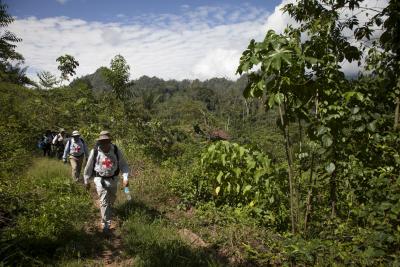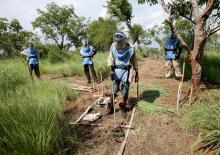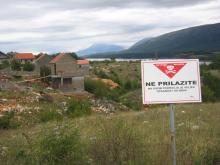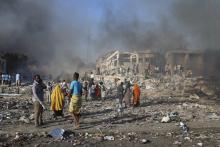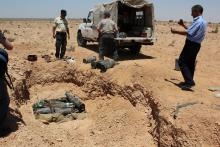Case prepared by Camila Dupret Torres, David Köller and Eva Vaz Nave, LL.M. students at Leiden University, under the supervision of Professor Robert Heinsch as well as Sofia Poulopoulou and Christine Tremblay (PhD researchers/research assistants), Kalshoven-Gieskes Forum, Leiden University.
A. PERU: LANDMINE AND CLUSTER MUNITION MONITOR
[…]
Contamination
Mine contamination in Peru results from a 1995 border conflict with Ecuador. The mined section of the border was predominantly in the Condor mountain range that was at the center of the dispute.
[…]
Article 5 Compliance
Under Article 5 of the Mine Ban Treaty (and in accordance with the eight-year extension granted by States Parties in 2008), Peru is required to destroy all antipersonnel mines in mined areas under its jurisdiction or control as soon as possible, but not later than 1 March 2017. Peru will not meet its 2017 deadline, and has requested a second extension, this time of seven years and 10 months’ duration, until 31 December 2024.
In the last five years, Peru has reported clearing a total of only some 170,000m2 of mined area with the destruction of 9,265 mines (see table below).
Mine clearance in 2011–2015
|
Year
|
Area cleared (m2)
|
Mines destroyed
|
|
2015
|
76,335
|
897
|
|
2014
|
8,458
|
478
|
|
2013
|
25,715
|
2,374
|
|
2012
|
13,791
|
4,021
|
|
2011
|
46,572
|
1,495
|
|
Total
|
170,871
|
9,265
|
[…]
B. LANDMINE TREATY MEETING CONCLUDES WITH ADVANCES IN STOCKPILE DESTRUCTION
Santiago, Chile - The Anti-Personnel Mine Ban Convention's Fifteenth Meeting of the States Parties (15MSP) has concluded a week of work in Santiago, Chile, recording success in stockpile destruction […].
Thirty-two (32) States Parties are still in the process of clearing mined areas including five in Latin America: Argentina, Chile, Colombia, Ecuador and Peru.
[…]
Peru, with a deadline until 1 March 2017, is carrying out joint operations with Ecuador to demine their common border. Peru received new information from Ecuador of the existence of 138 mine areas in the Cordillera del Condor. Due to this previously unknown contamination, Peru said it would be unable to meet its deadline. Peru was granted a new deadline until 31 December 2024 and will have to provide an updated work plan by 30 April 2018.
[…]
C. MINE ACTION PROGRAMMES IN LATIN AMERICA
[…]
2. REPORT ON THE MISSION TO PERU
[…]
One of the mine problems is contamination on the Peru-Ecuador border due to the brief but intense border war in 1995. This is a remote mountainous region, that is difficult to access, and part of which is uninhabited. Clearance is undertaken by the military forces of both countries as part of a joint project organised through the Organization of American States (OAS). The overall strategic goal of the project is to reinforce the peace process between the two countries.
[…]
D. SUPPORT FOR ACTION AGAINST ANTIPERSONNEL MINES IN ECUADOR AND PERU
[…]
RECOGNIZING the substantial progress made by Ecuador and Peru in mine-clearing, the destruction of stockpiles, […] and the special importance of humanitarian demining when it is carried out in a joint and consolidated fashion, as in the case of the work being done by the Governments of Ecuador and Peru in their common border area, which has resulted in information exchange and levels of cooperation that constitute an effective mutual confidence-building measure […];
[…]
NOTING the corresponding humanitarian demining efforts, as well as the awareness campaigns and assistance to victims in both countries;
[…]
RECOGNIZING:
[…]
The valuable cooperation being provided by member states, permanent observers, and other countries, to national efforts in Ecuador and Peru to forge ahead with their mine-clearing programs;
The financial cooperation from the European Union, through the “Antipersonnel Mines Project in the Cordillera del Cóndor, Peru-Ecuador,” which will allow both countries to continue their
concerted action against antipersonnel mines in a region of special social and ecological importance;
The establishment, […] in Peru, of the Regional Mine-Clearing Office in Bagua, Department of Amazonas;
The important work of coordination, promotion, and fundraising carried out by the General Secretariat through the Program for Comprehensive Action against Antipersonnel Mines (AICMA), which is devoted to humanitarian mine-clearing, the physical and psychological rehabilitation of victims and their families, prevention education, and the social and economic reclamation of demined areas; and
The efficient technical advice and support of the Inter-American Defense Board and the AICMA Program for the mine-clearing activities in Ecuador and Peru supported by the AICMA Program, through a group of international monitors selected by the Board and appointed thanks to cooperation among the Governments of Brazil, Chile, Honduras, and Nicaragua; and
TAKING NOTE of the efforts made by Ecuador and Peru, with the help of AICMA and the Government of Canada, to organize, in August 2003, in Peru, the Regional Seminar “Towards an antipersonnel-land-mine-free Hemisphere” and, in August 2004, in Ecuador, the Regional Conference on Mine Action in the Americas “One more step towards an antipersonnel mine-free Hemisphere […]”.
[…]
Discussion
I. Classification of the Situation and Applicable Law
1. How would you classify the armed confrontations between Peru and Ecuador in 1995? What would be the applicable law? (
GC I-IV, Art. 2;
P I, Art. 1)
3. Is Peru party to the legal instruments relating to anti-personnel landmines? Would a State not party to the above-mentioned instruments be bound by any obligation regarding anti-personnel landmines?
II. Destruction of Stockpiles, Mine Clearance and International Co-operation and Assistance
5. Is there an obligation of the Parties to the conflict to cooperate with the purpose of clearing the contaminated areas from anti-personnel landmines?
6. What is the role of the third States and international or regional organizations in the mine clearance process? Do third States have a duty to cooperate?
III. Elements Contributing to Respect for IHL
8. Do you see the link between the mine clearance action and the peace process between the States affected by armed conflict? Do you agree that the cooperation between States who in the past were the parties to the conflict could be a “confidence-building measure”?
9. In your opinion, apart from humanitarian considerations, why are the third States and international and regional organisations supporting the efforts of Peru and Ecuador in their mine-clearance efforts? Do you think that mine-clearance contributes to peace and stability in the region?

